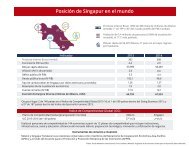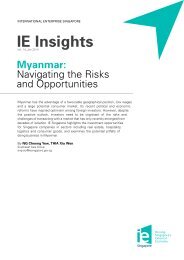basic-guide-to-exporting_Latest_eg_main_086196
basic-guide-to-exporting_Latest_eg_main_086196
basic-guide-to-exporting_Latest_eg_main_086196
Create successful ePaper yourself
Turn your PDF publications into a flip-book with our unique Google optimized e-Paper software.
For more information from the U.S. Department of Justice about the FCPA and the FCPA OpinionProcedure, visit usdoj.gov/criminal/fraud/fcpa.Although the U.S. Department of Commerce has no enforcement role with respect <strong>to</strong> the FCPA,it supplies general guidance <strong>to</strong> U.S. exporters who have questions about the law and aboutinternational developments concerning it. For more information, contact the Office of ChiefCounsel for International Commerce at (202) 482-0937 or visit 1.usa.gov/1vCMhf8.Import R<strong>eg</strong>ulations of Foreign GovernmentsImport documentation requirements and other r<strong>eg</strong>ulationsimposed by foreign governments vary from country <strong>to</strong> country.As an exporter, you must be aware of the r<strong>eg</strong>ulations that apply<strong>to</strong> your own operations and transactions. For instance, manygovernments require consular invoices, certificates of inspection,health certification, and various other documents. For sources ofinformation about foreign government import r<strong>eg</strong>ulations, seeChapter 4.Also, the large U.S. freight forwarding companies (and theirwebsites) may be able <strong>to</strong> provide information on the documentsyou need for specific countries.Before you export <strong>to</strong> a newcountry, remember <strong>to</strong> talk <strong>to</strong>the U.S. Commercial Service.Even if you’ve exported before,most foreign government haveunique import r<strong>eg</strong>ulations.North American Free Trade AgreementThe North American Free Trade Agreement (NAFTA), n<strong>eg</strong>otiated among the United States, Mexico,and Canada, came in<strong>to</strong> effect on January 1, 1994. It provided for the elimination of tariffs on mostgoods originating in the three countries over a maximum transition period of 15 years. For moreinformation on all aspects of NAFTA, please contact your local U.S. Commercial Service office.Tariffs will be eliminated only on goods that originate in one of the four ways defined in Article401 of the agreement:• Goods wholly obtained or produced entirely in the NAFTA r<strong>eg</strong>ion• Goods meeting a specific Annex 401 origin rule• Goods produced entirely in the NAFTA r<strong>eg</strong>ion, exclusively from originating materials• Unassembled goods and goods whose content does not meet the Annex 401 rule of originbut contains NAFTA r<strong>eg</strong>ional value of 60 percent according <strong>to</strong> the transaction value methodor 50 percent according <strong>to</strong> the net-cost methodArticle 502 of the NAFTA requires that importers base their claims of the country of origin on theexporters’ written certificates of origin, which may be the certificate of origin approved by theUnited States (CF 434), the Canadian certificate of origin (Form B-232), or the Mexican certificateof origin (Certificado de Origen). The certificate may cover a single shipment, or it may be usedas a blanket declaration for a period of 12 months. In either case, the certificate must be in theimporter’s possession when the importer is making the claim. See Appendix B for a list of all FreeTrade Agreements and what is required <strong>to</strong> take advantage of each.Chapter 10: International L<strong>eg</strong>al Considerations109





